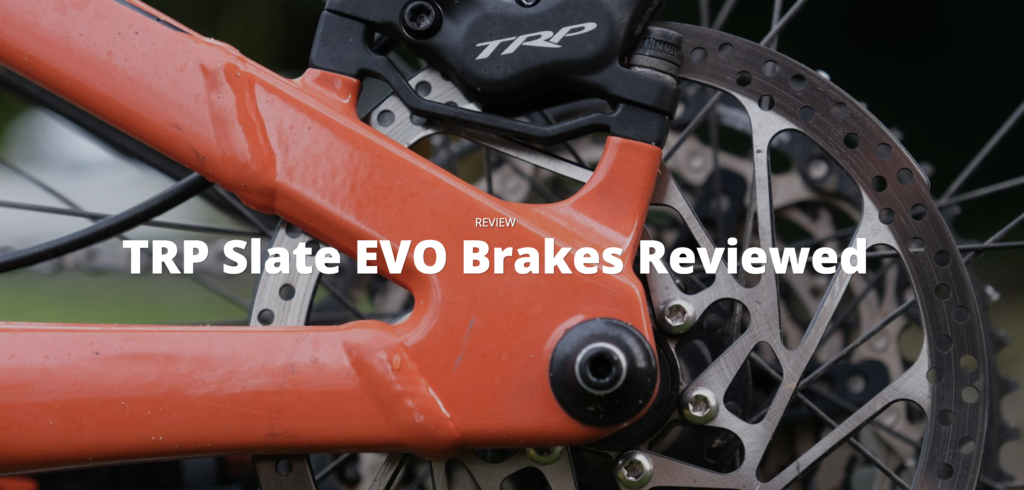
“Has there ever been a more fruitful sponsorship than TRP and Aaron Gwin? I can’t think of one that so thoroughly changed the perception of a brand, with TRP moving from a relative unknown to a serious contender in a very short period of time. For a guy that has experienced his fair share of sponsor-related drama over the years, Gwin really brought value to TRP.
Of course, if the product was crap, none of this would have meant anything. Some eyebrows would have been raised, a few curious fanboys would have taken the plunge, and then the scathing reviews would have halted any momentum. But the product is good! Both the Quadiem and the DH-R have a solid reputation and have kept TRP in the conversation.
But what about TRP’s lighter duty brakes? While not exactly “rare”, much less has been said about the Slate and the Trail compared to the DH-focused models. Having two bikes that could stand some brake upgrades felt like as good a reason as any to try to contribute to filling this void.”
View the original article on NSMB.com
TRP Slate EVO
We’re going to start with the Slate EVO (Slate from here on in). The Slate is very closely related to the Trail models, but has a few differences in the name of cutting costs. The Slates are meant to be an SLX competitor, while the Trail is more in line with XT. Both use the same size master cylinder piston (10mm), the same size caliper pistons (16mm for all four), the same upgraded pad choices (all 4-piston TRP brakes use the same pad style, which also happen to be cross-compatible with Shimano XT and SLX 4-piston brakes), and the same changes to accommodate the thicker 2.3mm rotor (I had TRP send me a 180mm rotor for the rear and 203mm for the front, to match what I already had in place, but they also have 220 and 223mm options). They both run on mineral oil and they both use the same 5mm hydraulic hose. The upgrades that the Trail receives over the Slate are in the name of heat tolerance (a larger caliper reservoir, hybrid composite pistons vs the stainless of the Slate) and general fanciness. The result is a pair of brakes that will feel and perform similarly to one another in most situations, but with the Trail able to take on some heavier duty service due to improved heat management.
Both brakes are relatively simple, no frills affairs. Far from a complaint, each brake has what it needs and not much more. The levers are comfortable on your fingers. The reach adjustments are easy to use and effective. The clamp design is simple (honestly, getting rid of the finicky little Shimano pokey release thing is enough of a reason to upgrade in my books). The levers are fairly long, and avoid some of the preciousness of other lever designs out there. The calipers are straight forward. Everything seems to have a place and a reason and there are no extra adjustments that don’t do anything or fins and gizmos tacked on.
The Slates will run you 139.99 USD per wheel, plus $43-55 per 6-bolt rotor (size dependent, and tack on another 10 bucks or so for Centerlock) and $15.99 per adapter.
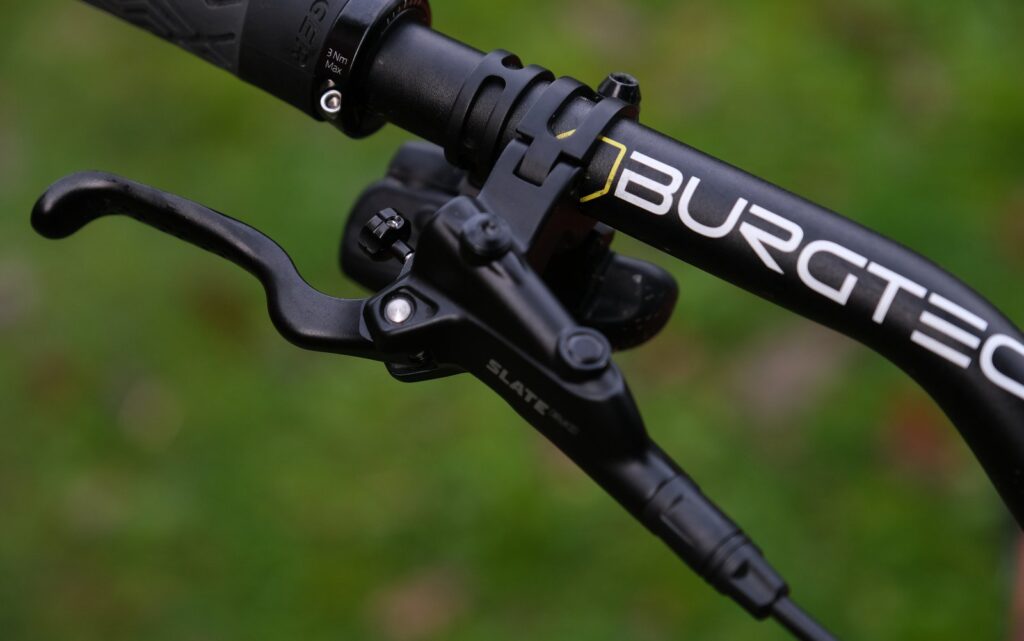
Set Up
Remember when swapping your brakes was no big deal? On a modern bicycle, this task now sucks. Why are cable ports too small to allow for an intact brake cable/olive/nut to fit through? Allowing the thing that needs to go through the thing to fit through the thing feels like it should be a primary design consideration. Instead, we have to chop a cable in order to pull it out of a frame? Insanity! There has to be a better way to do this, and it may be on the brake companies to come up with a solution to a problem caused by frame manufacturers. Worse, the Ibis also required a bit of cordless drill surgery to remove a stripped bolt from one of the cable ports. None of this is the fault of TRP, or would have been different with any other brake, but I seldom pass up a chance to bitch about such things. This experience also has me rethinking my head-to-head comparison using the Canyon. I may just stick to messing with one bike.
TRP ships all of their brakes bled and plugged, with the hose attached at the caliper end. It should be as easy as threading the hose through your frame, mounting the levers and calipers, cutting your lines to fit and bolting it all together. If you do this properly, you should be able to avoid any sort of bleed. I made the mistake of not using gravity to my advantage. The proper course of action would be to remove the lever from your bike once you have your hose length sorted, and then take the plug out in such a way that the fluid stays in place. With the levers bolted to the handlebar a few cc’s of brake fluid came out, so a bleed was required. This took a few tries, between my Shimano funnel and the Tektro kit that TRP sent along. I’d probably count on having to do this yourself, as well.
With the brakes mounted, I moved on to installing the rotors, which beg to be noticed as soon as you pull them out of the package. While a bump up from 1.8mm to 2.3mm doesn’t sound like much, they feel significantly stouter than what we’ve become accustomed to, and make me question why nobody thought of this sooner. They feel like a rotor should and I’m left with an impression that they’re going to be with me for the long haul.
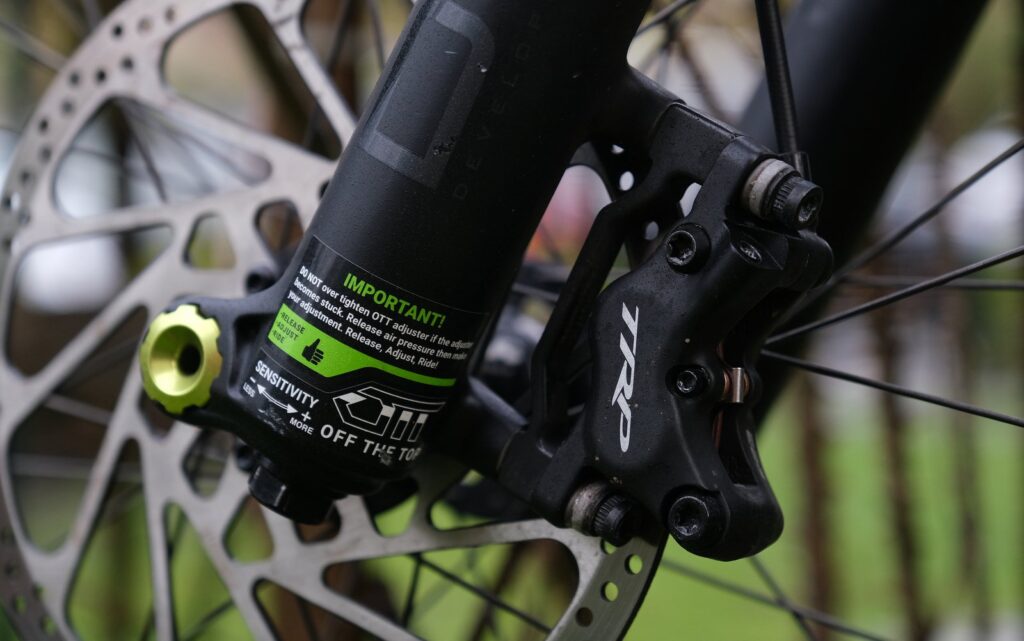
Another question that you might have is on shifter integration. TRP does offer your standard range of matchmaker and I-Spec shifter integration options, but I’m just rocking the straight up separate clamps here, so can’t comment on any of those other setups.
Rounding off our discussion about set up, we’ll touch on the sole adjustment available to the end user: the reach adjust dial on the inside of the lever. This dial is easy enough to manage, and it’s pretty trivial to get the levers to a point where they’re comfortable for your hand. There is no “free stroke” or “contact point” adjustment on this brake, so what you see is what you get. And what you get is a brake with incredibly short stroke. From max reach to fully locked up, the stroke is much less than the other brakes in my stable right now. It’s hard to put an exact number on this, as there are so many variables, but comparing the Slate to a Magura MT-5, the Slate had around 30mm of total stroke while the Magura had around 40mm (this was fairly unscientific, but I wanted to at least prove to myself that I wasn’t imagining things). With the Slates there is very little dead stroke so you’re very quickly in to functional braking. This is not something that I noticed while riding, but I did when I was standing around tugging on my brake levers.
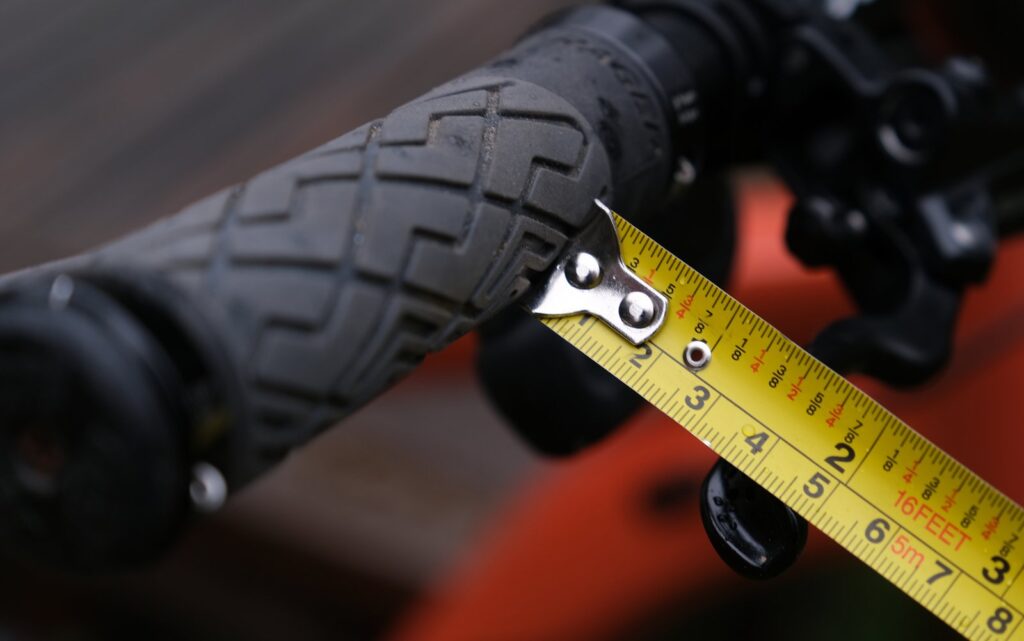
Performance
TRP included both the performance resin and sintered metallic pads for me to try, and they encouraged me to give the performance resin pads a shot before moving on to the metallic. To quote TRP directly:
The formula was developed directly with our UCI DH teams in the goal of making a pad that had a higher friction coefficient, a lower activation temperature and then to keep that friction consistent over a larger temperature gradient. Because of their unique resin formula, they don’t take a lot of temperature to activate the material, so they bed in very quickly, they offer the most amount of power off the first pull, and they actually last decently long in both dry and wet conditions.
From this perspective, TRP was successful. The brakes had a consistent amount of power whether it was your first pull at the top of the trail, or halfway down once your brakes had warmed up. They were super silent too. Outright power was okay, and significantly better than what I recently experienced with resin pads in an XT brake, which I thought were fairly lackluster brakes with resin pads installed. The Slates with resin pads are manageable, and could be a good choice for certain users looking for silence and consistency, or riding in areas that place less stress on brakes. At this point, the brakes felt “fine” to me, but I was looking for “great”. I decided to move on to the sintered pads.
This decision raised some questions, though. It feels like it’s very difficult to come to an agreement when having a conversation about resin vs. sintered pads. I’ve never experienced a resin pad that offered “more power” than sintered, but others claim the opposite. So, again I reached out to TRP for some more information and here is what they said:
Both resin and sintered pads will all have very similar friction coefficients once they reach their optimal temps. The difference is, resin will have a lower activation temp compared to sintered, and they will fall off faster than sintered. Saying one will have more friction than the other is really just a conditional statement depending on how much heat is flowing at any given time.
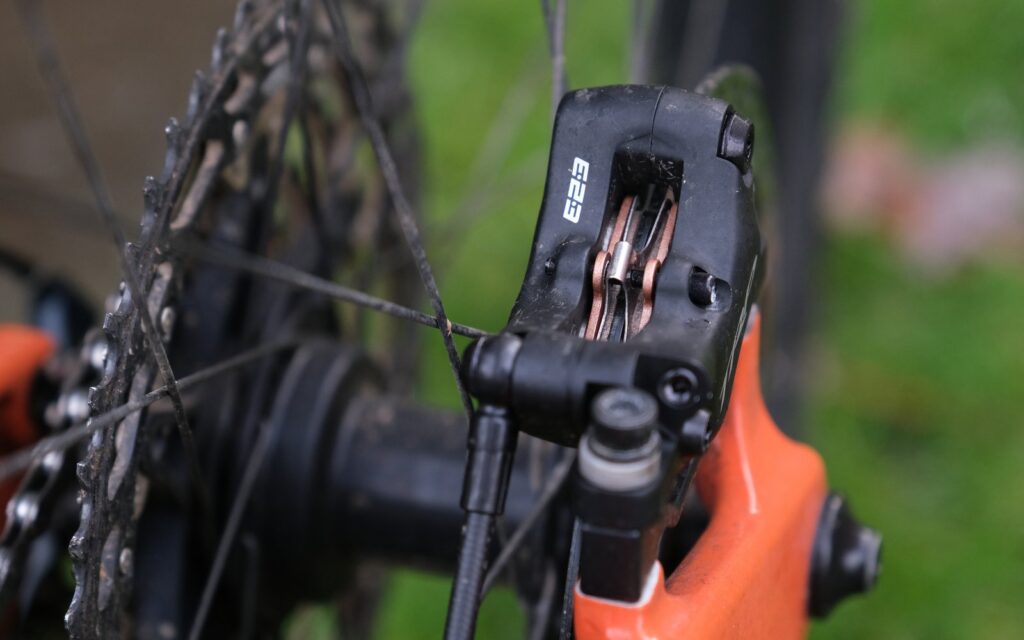
This offers some insight into why there might be such disagreement out there on pad material. It sounds like it’s possible that the pad that offers a particular user “the most power” could have a lot to do with how those pads are being used. For me, a not light guy who rides on steep terrain, sintered seems to be the answer. Perhaps your particular conditions could lead to the opposite conclusion. You’ll still be wrong, but at least we won’t have to argue about it now.
The good news for me is that moving to the metallic pads provided the increased braking performance that I was looking for. Yes, the metallic pads do require a bit more time to warm up (they’re not exactly quiet for the first few pulls in the wet) but this change turned these brakes into a contender.
Every mediocre bike rider out there has that one skill that they hang their hat on. For me, brake control is my thing. As a result, I’ve never been all that worried about modulation. Modulation, to me, is what you do with your fingers and complaining about “a lack of modulation” sounds to me like criticism of oneself.
These brakes may change my mind on that subject. I would say that they have a bit less outright power than an XT/SLX brake with metallic pads on an Ice-Tech rotor, but the power is more usable and consistent. It feels less like you’re riding a knife edge between maximum braking and locking up, and it’s easier to manage things at the extreme. The lever feel is very solid, without much flex or sponginess. It all results in nice, calm, predictable braking in any condition, dry or wet.
That’s not to say you should be throwing these things on your DH bike. The people around here who consider the Code to be an “all mountain” brake may be a little disappointed, but if that’s what you’re looking for, TRP has other brakes to compete in that segment. I would happily mount these brakes on any of the 150/160mm bikes in my possession, or on anything this side of a full on “Enduro” bike. I’m in no rush to re-mount the SLX brakes that I removed from the Ibis (which worked pretty well once I mated some Ice-Tech rotors with the stock metallic pads, but are a noticeable step behind with the crummy stock rotors). I love the thicker rotors, and while I haven’t tested their durability, they give me confidence that they will run true for the long haul. I love the simple lever and the basic clamp that doesn’t require you to juggle a separate piece (SRAM) or scream in frustration at a tiny little hole (Shimano). Most of all, I love the calm, predictable performance. These TRP Slate EVOs work well and they don’t cost a fortune (it does feel a bit crazy that 200 USD per wheel is considered “not a fortune”, but here we are) and what else do you really need?
Next Steps
What I haven’t done is use these brakes enough to comment on long term durability. I would estimate that I have something like 10-12 rides on the Slate EVOs. That’s 10-12 shoulder season/winter condition North Shore rides, so it’s not nothing, but I can’t pass judgment on their long term durability. Everything is ticking along well though. Pad wear seems fine and the thicker rotors are living up to their billing, but this hasn’t been a full season of use or anything like that. I am comfortable to speak about their general performance, though. My next step will be to get some time on the Trail EVOs, with the same pads and rotors, and perhaps come back to these at some point later in the season.
